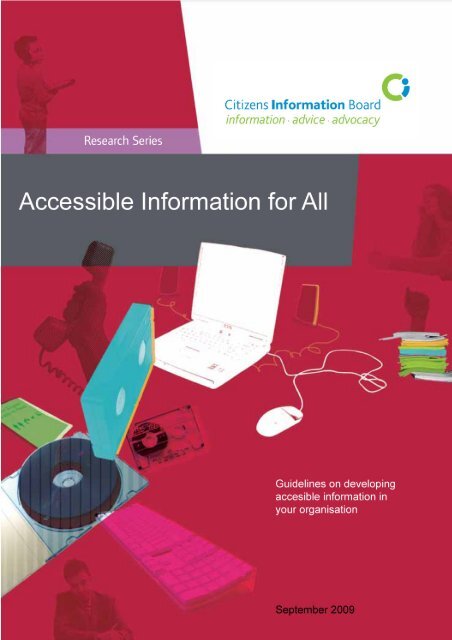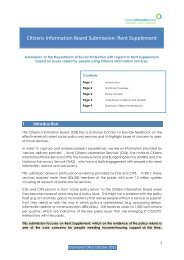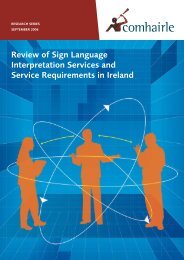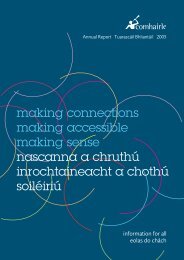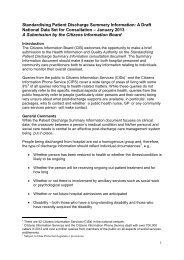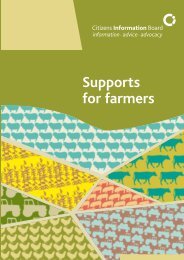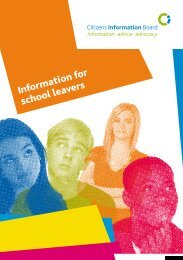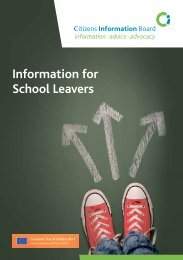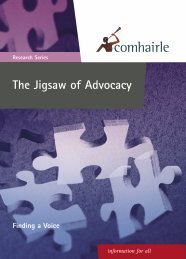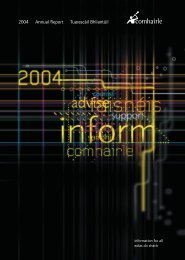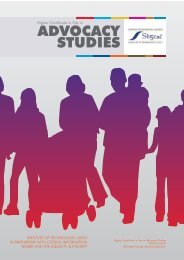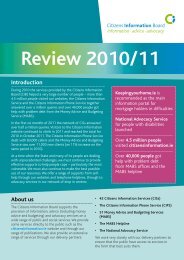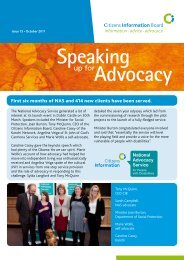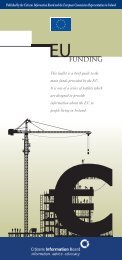Accessible information for all (2009) (pdf) - Citizens Information Board
Accessible information for all (2009) (pdf) - Citizens Information Board
Accessible information for all (2009) (pdf) - Citizens Information Board
You also want an ePaper? Increase the reach of your titles
YUMPU automatically turns print PDFs into web optimized ePapers that Google loves.
IntroductionThese practical guidelines, based on existing best practice, tell youwhat you should do as a public body to improve the accessibility ofyour <strong>in<strong>for</strong>mation</strong> and meet the requirements of the Disability Act2005.In particular, they offer advice on how to improve your <strong>in<strong>for</strong>mation</strong><strong>for</strong> people who experience <strong>in<strong>for</strong>mation</strong> barriers. These includeolder people and those with:• physical disabilities,• sensory disabilities (<strong>for</strong> example sight or hearing loss), and• learning disabilities.They also include:• people from new migrant communities,• people with literacy difficulties, and• others who may experience social exclusion, such ashomeless people, Travellers and people who are isolated or ininstitutions.Why is accessible <strong>in<strong>for</strong>mation</strong> important?In<strong>for</strong>mation is an important tool in our lives, enabling us to accessservices and entitlements and exercise our rights. All people needaccess to accurate <strong>in<strong>for</strong>mation</strong> that <strong>all</strong>ows them to deal witheveryday issues. Some people, however, may need additionalsupport to access the <strong>in<strong>for</strong>mation</strong> they need.Many agencies and organisations in the public, private andvoluntary sectors have a key role to play in providing accessible<strong>in<strong>for</strong>mation</strong> and making a real difference to people’s lives.Providing accessible <strong>in<strong>for</strong>mation</strong> can help you to reach a largeraudience and can enhance the quality and efficiency of yourcustomer services.2
What it means to make <strong>in<strong>for</strong>mation</strong> accessibleMaking <strong>in<strong>for</strong>mation</strong> accessible, however it is given – face to face,on a website, in print, on the phone or on DVD - means makingsure that the language and <strong>for</strong>mat used as well as the images anddesign are clear, appropriate and understandable.Different media and <strong>for</strong>mats <strong>for</strong> different audiencesIt is best to see <strong>in<strong>for</strong>mation</strong> as something you provide in a range of<strong>for</strong>mats <strong>for</strong> different:• audiences,• uses, and• delivery channels, (such as telephone, face to face, printedpages or websites)We use <strong>in<strong>for</strong>mation</strong> in different ways today and access it throughdifferent media. For example, we access:• written <strong>in<strong>for</strong>mation</strong> from books, leaflets, text messages andwebsites,• audio <strong>in<strong>for</strong>mation</strong> over the phone or from the radio, theInternet, podcasts and CDs, and• visual <strong>in<strong>for</strong>mation</strong> from television, the Internet and DVDs.Making <strong>in<strong>for</strong>mation</strong> available in as many <strong>for</strong>mats as possiblemeans that we give everyone a choice of how they want to access<strong>in<strong>for</strong>mation</strong>. Knowing our clients and asking them about theirneeds will tell us what <strong>for</strong>mats we need to provide.Making <strong>in<strong>for</strong>mation</strong> accessible to people with disabilitiesFinding practical ways to reasonably accommodate the needs ofpeople with physical and sensory disabilities is now required bylaw, under the Disability Act 2005. As you provide <strong>in<strong>for</strong>mation</strong> andconsult with those you work with, it will be important to considerthe needs of <strong>all</strong> people with disabilities, <strong>for</strong> example those:3
• who are deaf or hard of hearing,• with mental health difficulties,• with a vision impairment,• with learning disabilities, and• with illnesses that limit their understanding and decisionmakingThe Disability Act requires organisations providing services and<strong>in<strong>for</strong>mation</strong> to accommodate the needs of people with disabilities.You can find further <strong>in<strong>for</strong>mation</strong> on the Disability Act from theNational Disability Authority website, www.nda.ie.The Equal Status Acts 2000 and 2004 require providers of goodsand services to reasonably accommodate people with disabilities.Under the Acts service providers must make changes, atreasonable costs, to enable people with disabilities to use theirservices. You can find further <strong>in<strong>for</strong>mation</strong> on the Equal Status Actsfrom the Equality Authority’s website, www.equality.ie4
Fact Sheet 1: Carrying out an <strong>in<strong>for</strong>mation</strong> access auditAn <strong>in<strong>for</strong>mation</strong> accessibility audit can help an organisation toestablish what it is doing, if <strong>in<strong>for</strong>mation</strong> is reaching those who needit, where barriers exist and where there are gaps in your service.This is important as <strong>in<strong>for</strong>mation</strong> accessibility is required under the2005 Disability Act. It is good practice to carry out an audit as partof your approach to improving <strong>in<strong>for</strong>mation</strong> accessibility.How can you carry out an <strong>in<strong>for</strong>mation</strong> access audit?Staff can carry out the access audit but it is better to bring inexperts to carry out the audit <strong>for</strong> you. You can also commissionspecialists to audit your website and electronic communications(see Fact Sheet 5).The following are the main areas to cover in an <strong>in<strong>for</strong>mation</strong>accessibility audit:• policies on <strong>in<strong>for</strong>mation</strong> accessibility;• written <strong>in<strong>for</strong>mation</strong> and the different <strong>for</strong>mats you provide;• website and electronic <strong>in<strong>for</strong>mation</strong>;• translation and interpretation services that you provide;• systems in place to review who uses your services;• methods <strong>for</strong> consulting with service users;• accessibility of your <strong>in<strong>for</strong>mation</strong> centre;• staff training and awareness.Once you have carried out the audit, draw up an action plan withtimescales and responsibilities. Improving <strong>in<strong>for</strong>mation</strong> accessibilityis a gradual and continuous process.A key outcome of the audit is to improve <strong>in<strong>for</strong>mation</strong> accessibility.This can best be measured if the customer notices that the qualityand accessibility of the service has improved. Consulting withcustomers will help you to measure this.The Revenue Commissioners’ Central Revenue In<strong>for</strong>mationOffice deals with over 300,000 customer visits each year. In 2007,following major renovations to its central <strong>in<strong>for</strong>mation</strong> office, theRevenue Commissioners received an Excellence throughAccessibility Award. After consulting with the National Disability5
Authority, the Revenue Commissioners organised disabilityawareness training <strong>for</strong> staff to improve the service to customers.They also placed Braille signs at eye level and used colourcontrast with dark text on a white background to make signs easierto read.A spokesperson said this resulted in: “much greater awarenessthroughout the organisation both at management and staff levelabout people with disabilities and their needs and entitlements…What you have to do to make your buildings, systems and serviceaccessible is not rocket science, it re<strong>all</strong>y just needs a bit ofthought, a bit of learning and being creative in your solutions…When we learned what we had to do and when we had the rightattitude towards doing it, it was amazing how easy it was to do.”Further resourcesNational Disability Authority www.nda.ieInstitute <strong>for</strong> Design and Disability. www.idd.ieNational Council <strong>for</strong> the Blind of Ireland (NCBI) www.ncbi.ie6
Fact Sheet 2: Consulting with service usersIt is important to consult with service users when planning,developing, managing and reviewing <strong>in<strong>for</strong>mation</strong> services. Youshould not only know your audience but also work closely withthem. To find out if your <strong>in<strong>for</strong>mation</strong> is accessible, relevant andeasy to understand, consult with and get feedback from your<strong>in<strong>for</strong>mation</strong> users.A transparent and simple feedback and complaints procedureshows that your organisation is serious about providing the best<strong>in<strong>for</strong>mation</strong> service possible.Meaningful and appropriate consultation with service users andlocal communities is important in identifying how to provide<strong>in<strong>for</strong>mation</strong> in the most accessible ways. As the National DisabilityAuthority’s Ask Me: Guidelines <strong>for</strong> Effective Consultation withPeople with Disabilities (2002) states: “Getting the consultationprocess right <strong>for</strong> people with disabilities means getting it right <strong>for</strong>everybody.”“Monaghan local authorities define social inclusion as a processthat aims to enable each individual to have equal opportunity ofaccess to services, facilities and <strong>in<strong>for</strong>mation</strong> and to have equalityof opportunity to make decisions that affect their lives. They feel,“with regard to social inclusion, if the shoe does not fit, the shoeneeds to change, not the foot.” Monaghan local authorities haveproduced “Making Monaghan <strong>Accessible</strong>”, their “Disability ActImplementation Plan 2007 – 2015”. The plan sets out in detail howthey will meet their obligations under the Disability Act 2005. Theyhave, in the plan, committed to ongoing consultation with serviceusers to ensure that they are reaching targets and goals set outwithin the implementation plan and to providing a range of servicesthat are fully accessible to everyone. The implementation plan canbe obtained from their Access Officer and is available in a numberof different <strong>for</strong>mats on request.7
Involving service users when monitoring and managing yourserviceThere are many levels at which you can involve users inmonitoring and managing your service:• Individual level: individuals are directly involved in providing<strong>in<strong>for</strong>mation</strong>. This could be in a one-to-one <strong>in<strong>for</strong>mation</strong> sessionor when an individual uses one of your <strong>in<strong>for</strong>mation</strong> services.• Operational level: service users are involved in planning day-today<strong>in<strong>for</strong>mation</strong> services.• Strategic level: service users are involved in planning the futuredirection of the service.• Governance level: service users and people fromdisadvantaged groups are involved in managing the service, <strong>for</strong>example, on the board of management, working groups or otherconsultative bodies of your organisation.How can you get feedback on what you have done?• Keep a record of the different <strong>in<strong>for</strong>mation</strong> <strong>for</strong>mats that peoplehave asked <strong>for</strong> and used.• Listen to what people say about the best way to provide<strong>in<strong>for</strong>mation</strong>. Encourage people to make suggestions andpropose changes.• Have a system <strong>for</strong> feedback, <strong>for</strong> example provide commentcards or <strong>all</strong>ow feedback on your website, so that <strong>in<strong>for</strong>mation</strong>users can comment on the accessibility of your <strong>in<strong>for</strong>mation</strong>service. Make sure that comment cards and websites areaccessible.• Ask <strong>in<strong>for</strong>mation</strong> users to give you feedback on the different<strong>for</strong>mats that you provide and how your existing <strong>in<strong>for</strong>mation</strong>could be made more accessible.• Consider how you can involve service users in the design ofyour service or the production of a new publication.• Work in partnership with different organisations and groups tobuild understanding of the <strong>in<strong>for</strong>mation</strong> needs of service users sothat this can in<strong>for</strong>m your work.• Ask your service users what support they need in accessing<strong>in<strong>for</strong>mation</strong>.• Set up a quality circle or a user panel that represents differentuser groups.• Involve representative organisations and people fromdisadvantaged groups in managing your organisation through8
membership of your <strong>Board</strong> of Directors, participation incommittees or working groups, organisational reviews andevaluations.Co. Louth <strong>Citizens</strong> In<strong>for</strong>mation Service has produced an<strong>in<strong>for</strong>mation</strong> book <strong>for</strong> parents of children with a disability. Theyconsulted with the parents of children with a disability and askedthem what difficulties they had in getting the <strong>in<strong>for</strong>mation</strong> theyneeded. They also met with support groups and asked them whatsupport they provided. This <strong>in<strong>for</strong>mation</strong>, and <strong>in<strong>for</strong>mation</strong> fromdifferent websites and government departments, was compiled intoa book using simple, easy-to-understand language. Contact<strong>in<strong>for</strong>mation</strong> <strong>for</strong> parent support groups was included. The book waslaunched by a government minister and distributed to supportgroups, disability groups and <strong>Citizens</strong> In<strong>for</strong>mation Centres acrossthe country.Issues to consider when organising consultation events andfocus groups:• Are the questions clear and accessible to people withdisabilities and to different minority ethnic communities?• Do the questions posed and methods used make inappropriateassumptions or stereotype particular groups?• Have facilitators been briefed about the objectives of theconsultations?• Are facilitators trained to be aware of disability and culturalissues?• Have facilitators been recruited from disability and minorityethnic communities?• Are consultation materials written in accessible, plain Englishand translated into relevant languages?• Have the people who attended the consultations been givencopies of the report or notes from the consultations in theirpreferred accessible <strong>for</strong>mats?Further resourcesNational Disability Authority (2002) Ask Me: Guidelines <strong>for</strong>effective consultation with people with disabilities9
Combat Poverty Agency (2000) Guidelines on consulting withpeople who live in poverty10
Fact Sheet 3: Working in partnershipWorking with representative and advocacy organisations can helpyou to:• deliver <strong>in<strong>for</strong>mation</strong> where it is needed;• identify gaps in the <strong>in<strong>for</strong>mation</strong> you provide; and• have a reliable source of referral to more specialist adviceand services.No organisation will have <strong>in<strong>for</strong>mation</strong> on or connections with <strong>all</strong>potential <strong>in<strong>for</strong>mation</strong> users. For this reason, it is important to workin partnership to share <strong>in<strong>for</strong>mation</strong>, contacts and expertise.Linking with advocacy and representative organisationsTo improve access to <strong>in<strong>for</strong>mation</strong> it is important to link withorganisations that have trusted relationships with specific groupsof <strong>in<strong>for</strong>mation</strong> users. This may include specialist <strong>in<strong>for</strong>mation</strong>centres, outreach workers, local groups and groups representingservice users. Groups which provide outreach services andspecialist support might also help to distribute your <strong>in<strong>for</strong>mation</strong>. Itis useful to have a link worker who is responsible <strong>for</strong> linking withother organisations and to name a contact person in your<strong>in<strong>for</strong>mation</strong> centre.The Immigrant Council of Ireland provides <strong>in<strong>for</strong>mation</strong> about theimmigration system <strong>for</strong> people who come to Ireland to visit, work,study or live. This includes written <strong>in<strong>for</strong>mation</strong> in English, Arabic,Chinese, French, Portuguese and Russian, and languageinterpretation in face-to-face contacts or over the telephone. The<strong>Citizens</strong> In<strong>for</strong>mation <strong>Board</strong> has partnered with the Council toprovide regular updates <strong>for</strong> <strong>Citizens</strong> In<strong>for</strong>mation Centre staff onkey changes in immigration policy and a special phone line thatCICs can c<strong>all</strong> to get specialist <strong>in<strong>for</strong>mation</strong> and support.Sharing <strong>in<strong>for</strong>mation</strong> and co-ordinating activitiesThe best way to make partnerships beneficial is to pool expertise.You can share and exchange <strong>in<strong>for</strong>mation</strong> with local areapartnerships, community centres, local day centres <strong>for</strong> olderpeople, groups representing people with disabilities, migrantsupport organisations, shelters and hostels <strong>for</strong> homeless people,and community-based projects.11
The National Council <strong>for</strong> the Blind in Ireland (NCBI) providesBraille transcription, audio recording, audio description, disabilityawareness, website accessibility audits and access audits ofbuildings to groups and organisations that want to make their<strong>in<strong>for</strong>mation</strong> accessible to people who are blind and visionimpaired.Co-ordinating training, advice and other activities helps to promotelearning among organisations and to avoid duplication of work.You can also publicise <strong>in<strong>for</strong>mation</strong> about your services inmagazines and e-newsletters produced by community andrepresentative organisations. This is particularly helpful when<strong>in<strong>for</strong>mation</strong> is complex and specialised.Co. Offaly <strong>Citizens</strong> In<strong>for</strong>mation Service has a database ofcertified community interpreters on its website, put together by theTullamore Migrant Centre. Co. Offaly CIS acts as a broker bylinking community and voluntary organisations and individualsneeding an interpreter service. The Migrant Centre, which isfunded through the Department of Social & Family Affairs, helpsmigrant communities to integrate with local social, cultural andsporting organisations. It provides <strong>in<strong>for</strong>mation</strong> and help on issuessuch as immigration legislation, social welfare and employmentrights. The centre has also trained ethnic community interpreters tohelp others in their community to access local and nationalsupports and services and so increase their integration into Irishsociety.The <strong>Citizens</strong> In<strong>for</strong>mation <strong>Board</strong> is working with InclusionIreland to make its <strong>in<strong>for</strong>mation</strong> accessible to people with anintellectual disability. The first step is to produce a leaflet tointroduce people to their local <strong>Citizens</strong> In<strong>for</strong>mation Centre. Theleaflet describes what <strong>in<strong>for</strong>mation</strong> the CIC can provide, that it isfree and confidential, and that CIC <strong>in<strong>for</strong>mation</strong> officers will take thetime to explain the various options. In<strong>for</strong>mation providers havereceived training on how to provide <strong>in<strong>for</strong>mation</strong> to people with anintellectual disability. A focus group of people with an intellectualdisability will look at the leaflet to see if the <strong>in<strong>for</strong>mation</strong> is usefuland will help guide the <strong>Board</strong> in the next steps to take to make its<strong>in<strong>for</strong>mation</strong> more accessible.12
Fact Sheet 4: Designing <strong>in<strong>for</strong>mation</strong> <strong>for</strong> accessibilityIt is important that the content of your <strong>in<strong>for</strong>mation</strong> – whether it iswritten <strong>in<strong>for</strong>mation</strong>, an audio tape, a DVD or a video – is clearlystructured and that it is produced from a single source. This avoidsduplication and lets you update <strong>in<strong>for</strong>mation</strong> quickly and easily.(Single source publishing is explained later in this Fact Sheet).Once <strong>in<strong>for</strong>mation</strong> is designed <strong>for</strong> accessibility, you can then adaptit <strong>for</strong> different <strong>for</strong>mats and <strong>for</strong> the web. Fact Sheet 5 explains thedifferent <strong>for</strong>mats you can use and Fact Sheet 6 shows how toensure your website is accessible.Easy to read <strong>in<strong>for</strong>mation</strong> has many uses. It can be useful topeople with intellectual disabilities, to people with aphasia and topeople with a low level of literacy in English, among others. Aspecial interest group has <strong>for</strong>med to agree an approach on howpeople can make <strong>in<strong>for</strong>mation</strong> easy to read in Ireland. It includesspeech and language therapists, researchers, policy makers andothers with experience of creating easy to read <strong>in<strong>for</strong>mation</strong>.Their aim is to produce guidelines by reviewing the literature,discussing their previous experiences and actively engaging withpeople who will benefit from easy to read <strong>in<strong>for</strong>mation</strong>.What can you do to make your written <strong>in<strong>for</strong>mation</strong>accessible?The guidelines below apply to <strong>all</strong> <strong>in<strong>for</strong>mation</strong>, including electronicpublications and websites. They are relevant <strong>for</strong> word processingfiles and <strong>for</strong> other file <strong>for</strong>mats such as PDF and HTML. They willhelp you to structure, write and design your <strong>in<strong>for</strong>mation</strong> so that itcan be made accessible in different <strong>for</strong>mats and in Clear Print.a) Design and layout• Use simple, clear English so that your publications areaccessible to everyone. The National Adult Literacy Agency(NALA) can provide help in writing plain English texts. (Seefurther resources below).• Use Clear Print design which takes into account things like fonttype and size, colour contrast between background and text,and page navigation. Examples of Clear Print design are usingat least 14 point font size and aligning paragraphs to the left.13
(See further resources below <strong>for</strong> more guidance on Clear Printdesign).Age and Opportunity uses RNIB Clear Print Guidelines in itspublications. It has also given <strong>in<strong>for</strong>mation</strong> on how to makepublications clearer and more legible to its Bealtaine festivalpartners, which include arts centres, cultural institutions andcounty council arts offices.b) Structuring your document• Create a structure so that your written <strong>in<strong>for</strong>mation</strong> can beaccessed through a screen reader. A screen reader will readaloud <strong>in<strong>for</strong>mation</strong> from your computer screen so that you canlisten to it.• Base your structure on Microsoft Word styles and headings.Use the heading style in Word, such as ‘Heading 1’, ‘Heading 2’and so on, to create headings rather than trying to make yourtext look like a heading by using bold <strong>for</strong>matting. Using theheading style lets screen readers create an outline of thedocument.• Add space around paragraphs by using style <strong>for</strong>matting optionsrather than using carriage returns. This is particularly importantto people who use a screen reader.c) Using images and tables in electronic documents• Describe the <strong>in<strong>for</strong>mation</strong> in words as well as in images.• When creating columns of text, use the built-in table tools. Donot use tabs to create tables.• Keep the tables simple.d) Linking your documents to web pages• Use descriptive text <strong>for</strong> links.• Make sure that each hyperlink describes the content to which itlinks. This is important because hyperlinked text such as ‘clickhere’ can be confusing <strong>for</strong> people who use screen readers.f) Training your staff• Train your staff on how to produce accessible writtendocuments.• Make sure the training addresses equality issues as well asnegative stereotypes and attitudinal barriers.14
If you provide <strong>in<strong>for</strong>mation</strong> in different <strong>for</strong>mats, say this clearly in theoriginal publication. ‘Different <strong>for</strong>mats available on request.’ It isimportant to state which <strong>for</strong>mats are available and where to getthem.Inclusion Ireland promotes accessible <strong>in<strong>for</strong>mation</strong> <strong>for</strong> people withintellectual disabilities. Its website provides up to date <strong>in<strong>for</strong>mation</strong>on developments in service provision, legislation and social policy.It also produces accessible CDs and booklets in Easy to Read<strong>for</strong>mat.One example is the ‘My Voice, My Choice’ advocacy pack, whichcontains <strong>in<strong>for</strong>mation</strong> booklets in Easy to Read <strong>for</strong>mat and a CD.The pack helps people with intellectual disabilities to have a betterunderstanding of their rights and how to get their voice heard whenexerting their rights.Single source publishingA more advanced method <strong>for</strong> producing a document is singlesource publishing. This involves publishing <strong>in<strong>for</strong>mation</strong> from asingle source that can later be trans<strong>for</strong>med into a variety ofdifferent output <strong>for</strong>mats, such as HTML <strong>for</strong> the web, PDF <strong>for</strong>printing or Braille transcription.The source document is written in a computer language c<strong>all</strong>edXML (Xtensible Markup Language). XML does not use <strong>for</strong>mattingor typesetting which means that the <strong>in<strong>for</strong>mation</strong> can easily bechanged into other output <strong>for</strong>mats.The benefit of single source publishing is that it avoids having toedit and produce different versions of the one document. Thisreduces costs, reduces the possibility of errors occurring andmakes it easier to update documents as only the ‘master’ (singlesource) file has to be updated.Single source publishing is particularly useful <strong>for</strong> organisations thatproduce <strong>in<strong>for</strong>mation</strong> in a variety of <strong>for</strong>mats such as Braille and theweb.Further resourcesNational Adult Literacy Agency, Plain English GuidelinesPlain English Campaign, the Plain English Guide to Design andLayout15
Plain English Campaign, How to Write in Plain EnglishPlain English Campaign, Plain English Tips <strong>for</strong> Clear WebsitesNational Disability Authority, First Steps in Producing <strong>Accessible</strong>PublicationsThe document is available in HTML, PDF and Word <strong>for</strong>mats.National Disability Authority, Code of Practice on Accessibility ofPublic Services and In<strong>for</strong>mation provided by public bodies Thisgives guidance to public bodies on how to improve access towritten <strong>in<strong>for</strong>mation</strong>. It is available in HTML, Low Resolution PDF,Large Print, Plain English PDF, and Easy to Read PDF <strong>for</strong>mats.Assist Ireland http://www.assistireland.ie A comprehensive onlineresource database developed by the <strong>Citizens</strong> In<strong>for</strong>mation <strong>Board</strong>with <strong>in<strong>for</strong>mation</strong> on assistive technology products, suppliers andresources related to daily living and disability in Ireland.National Council <strong>for</strong> the Blind of Ireland (NCBI) provides guidanceon how to make written documents accessible to <strong>all</strong>, with particularfocus on clear print layout and design. NCBI Make it ClearLighthouse International (USA), Guidelines on Colour and EffectiveColour <strong>for</strong> People with Visual Impairments. www.lighthouse.orgRoyal National Institute <strong>for</strong> the Blind, See it Right: Guidelines onproducing accessible <strong>in<strong>for</strong>mation</strong>. This includes a book and CD.www.rnib.org.ukWeb Aim, Provides guidance on how to structure a Worddocument provides different text <strong>for</strong> images and save files toHTML.SAIF, Provides a wide range of resources and checklists on how tomake documents accessible <strong>for</strong> disabled people.http://www.saifscotland.org.uk/Mencap, UK, Am I Making Myself Clear? (2002). Guidelines <strong>for</strong>accessible writing, www.mencap.org.uk16
Fact Sheet 5: Providing your <strong>in<strong>for</strong>mation</strong> in different<strong>for</strong>matsThis Fact Sheet introduces the different <strong>for</strong>mats you can use tomake your <strong>in<strong>for</strong>mation</strong> accessible to a wide audience. Forexample, many people access <strong>in<strong>for</strong>mation</strong> through audio andvideo technology, podcasts and sound files on their computers,IPods and MP3 players. Just as providing <strong>in<strong>for</strong>mation</strong> in an Easyto Read <strong>for</strong>mat helps everyone, not just people with learningdisabilities, providing different <strong>for</strong>mats widens choices <strong>for</strong>everyone. It also helps you to meet the requirements of theDisability Act, 2005.As Fact Sheet 4 shows, structuring your <strong>in<strong>for</strong>mation</strong> correctlymakes it easier to transfer <strong>in<strong>for</strong>mation</strong> into different <strong>for</strong>mats,including HTML, PDF documents, Clear Print documents, largeprint, Easy to Read documents, Braille, video and audio.A master copy will make it more manageable and cost effective ifyou have a quick method of producing different <strong>for</strong>mats and clearlyadvertise that these <strong>for</strong>mats are available on request.Overview of different <strong>for</strong>matsBraille: Braille is a reading and writing system of raised dots that isread by touch. To transcribe a document into Braille, the Worddocument must be structured correctly and without complex<strong>for</strong>matting such as graphs or bar charts. Braille should beproduced by a professional Braille transcription agency. For more<strong>in<strong>for</strong>mation</strong> on Braille and on making documents accessible topeople who are blind or vision impaired, visit the website of theNational Council <strong>for</strong> the Blind in Ireland, www.ncbi.ie or loc<strong>all</strong> 185033 43 53.By law, <strong>all</strong> pharmaceutical packaging and patient <strong>in<strong>for</strong>mation</strong>leaflets (PILs) must be available in Braille. Through thePharmabraille initiative, NCBI has developed a training course <strong>for</strong>pharmaceutical companies that teaches the basics of Grade 1Braille. Interest from pharmaceutical companies across Ireland hasbeen strong. A leading Irish packaging company works with NCBIto produce Braille labels <strong>for</strong> pharmaceutical companies in Irelandand internation<strong>all</strong>y.17
Audio: Audio <strong>in<strong>for</strong>mation</strong> is easily stored on CDs, audio cassettesand sound files.New technology makes it easy to transfer <strong>in<strong>for</strong>mation</strong> into an audio<strong>for</strong>mat, <strong>for</strong> example by downloading podcasts or audio files fromthe Internet onto IPods and MP3 players. In some cases it mightbe helpful to provide subtitles and / or an Irish Sign Language (ISL)signer along with an audio file.If you are creating audio files, it is important to use professionaland experienced readers and high-quality commercial recordingequipment. The NCBI Media Centre has five recording studios anda sound engineering team. It converts hard and soft documentsinto Braille and audio <strong>for</strong>mats and is the largest centre of its kind inIreland. For more <strong>in<strong>for</strong>mation</strong>, see www.ncbi.ie.Video: Video is an accessible way of providing <strong>in<strong>for</strong>mation</strong> toanyone, not just those who cannot read. You can see this in thepopularity of YouTube and video players on IPods. However, videoclips do not work well <strong>for</strong> conveying detailed <strong>in<strong>for</strong>mation</strong> such asdirectories of services.DVDs and video are particularly helpful <strong>for</strong> deaf people and thosewith literacy difficulties. DVDs and videos with subtitles and IrishSign Language are a preferred <strong>for</strong>mat <strong>for</strong> many deaf people. Whencreating DVDs and videos, always consider using narration, onscreentext and graphics, and aim <strong>for</strong> the highest possible soundand video quality. The Irish Deaf Society has facilities <strong>for</strong>producing signed videos and DVDs. Its website has an example ofa video with sign language. For more <strong>in<strong>for</strong>mation</strong>, go towww.irishdeafsociety.ie.An example of how video can be used to provide <strong>in<strong>for</strong>mation</strong> is aDVD on family reunification policies in Ireland, produced by theForum on Migration and Communication (FOMACS) with theImmigrant Council of Ireland. The DVD makes immigration lawon family reunification accessible to a large number of people. Formore <strong>in<strong>for</strong>mation</strong>, see www.immigrantcouncil.ie.Audio Description: Audio description is the name given to anarrative track on television, movies, the per<strong>for</strong>ming arts and thevisual arts to communicate the story to people who are blind orvision impaired. Audio description enriches the enjoyment of the18
plot or content of visual passages or moments in a programme,per<strong>for</strong>mance or film. It is also a relevant <strong>for</strong>mat <strong>for</strong> people withlearning disabilities, literacy difficulties and anyone who enjoyslistening to <strong>in<strong>for</strong>mation</strong>.NCBI also provides an audio description service <strong>for</strong> <strong>in<strong>for</strong>mation</strong>produced in a video <strong>for</strong>mat. See www.ncbi.ie.Mary has been profoundly deaf since birth and uses Irish SignLanguage (ISL) as her main mode of communication. Mary’sliteracy level is low and she has difficulty understanding mostwritten <strong>in<strong>for</strong>mation</strong>. During the last census, the Central StatisticsOffice sent Mary the census <strong>in<strong>for</strong>mation</strong> on a DVD with Irish SignLanguage translation. This gave Mary the confidence to fill out thecensus <strong>for</strong>m <strong>for</strong> the first time. In previous years, she had madeexcuses to the census officer about why she hadn’t filled out the<strong>for</strong>m.Plain English: Plain English is written to be understood. Usingplain English ensures that documents are written clearly andconcisely, there is no confusion about meaning and jargon is keptto a minimum. All documents produced to provide <strong>in<strong>for</strong>mation</strong> tothe public should be written in plain English. NALA Plain EnglishGuidelinesEasy to read: Easy to Read documents are particularly important<strong>for</strong> people with intellectual disabilities, people with literacydifficulties and people whose first language is not English. Inpractice, many of us like an Easy to Read document because the<strong>in<strong>for</strong>mation</strong> is short, clear, illustrated and structured around keymessages. Easy to Read documents can serve as summaries atthe start of a written document or can stand alone. Always makesure that the Easy to Read document has the same structure,message and content as <strong>all</strong> other <strong>for</strong>mats. A number o<strong>for</strong>ganisations can help you to prepare Easy to Read documents.For more <strong>in<strong>for</strong>mation</strong>, go to Inclusion Ireland's website,www.inclusionireland.ie19
BreastCheck has developed an Easy to Read document onbreast screening to improve access to and participation inBreastCheck services by women with intellectual and learningdisabilities. BreastCheck found that the document was widely usedby women, particularly women with little English. BreastCheck is afree health service, funded by the Department of Health andChildren, which aims to reduce deaths from breast cancer byfinding and treating the disease at an early stage. The booklet, AGuide to Breast Screening provides <strong>in<strong>for</strong>mation</strong> <strong>for</strong> carers, family,friends, medical guardians and women themselves.HIQA, in association with Inclusion Ireland, produced an Easy toRead version of the draft National Quality Standards <strong>for</strong>Residential Services <strong>for</strong> People with Disabilities. This wasdeveloped following discussions at focus groups where peoplewith disabilities gave feedback on the standards. The Easy toRead version gives people with intellectual disability <strong>in<strong>for</strong>mation</strong> onthe standards that they can understand. Because of this they knowwhat to expect of the residential services they use and can maketheir voice heard if the standards are not met.Electronic documents: Documents can be publishedelectronic<strong>all</strong>y as PDFs, HTML or MS Word documents. Theguidelines contained in Fact Sheet 4 on designing your <strong>in<strong>for</strong>mation</strong><strong>for</strong> accessibility also apply to documents that are publishedelectronic<strong>all</strong>y.PDFs should be structured so that they can be read and navigatedusing assistive technologies such as the text-to-speech softwareused by web users who are blind and vision impaired. However,tagged PDFs are not fully accessible to <strong>all</strong> assistive technologies,so you should provide a fully accessible <strong>for</strong>mat, such as HTML, aswell.MS Word documents may not be accessible unless they havebeen structured using heading styles. Also, images and<strong>in<strong>for</strong>mation</strong> in tables are not accessible in MS Word <strong>for</strong>mat. Formore <strong>in<strong>for</strong>mation</strong>, see the National Disability Authority’s website,www.nda.ie.<strong>Accessible</strong> emails: Emails have become a vital source ofcommunication so it is important that you develop accessible tools20
<strong>for</strong> email use. Use plain English in <strong>all</strong> emails, write clearly andavoid jargon. Use plain text emails so that readers can see the<strong>in<strong>for</strong>mation</strong> in the way you intend. Plain text emails are the mostaccessible, especi<strong>all</strong>y <strong>for</strong> people using screen readers. A ScreenReader will read aloud <strong>in<strong>for</strong>mation</strong> from your computer screen soyou can listen to it. If you use HTML emails, follow theaccessibility guidelines <strong>for</strong> web pages, which you will find in FactSheet 6.For plain text emails, use the Text Email Newsletter (TEN)Standard – see www.headstar.com/ten. When emailing to groupsyou can offer a plain text version, a plain text with the HTMLversion attached, or you can let the recipient choose which versionto subscribe to.Pictures and symbols: Pictures and symbols can make<strong>in<strong>for</strong>mation</strong> easy to understand and are a useful way tocommunicate <strong>in<strong>for</strong>mation</strong>. Symbols are usu<strong>all</strong>y simple linedrawings that are used to represent words and ideas. They canhelp to make written <strong>in<strong>for</strong>mation</strong> accessible. People withintellectual disabilities and literacy difficulties may find illustrationsand symbols a more effective <strong>for</strong>m of communication. In addition,pictures and symbols can be used to communicate with peoplewith mental health difficulties or to approach areas difficult todiscuss. Symbols, illustrations, photographs and pictures can <strong>all</strong>help people to understand the content of the document.NCBI can tell you how to make pictures and symbols accessible topeople who are blind and vision impaired.It is important to use pictures and symbols appropriately. Varioustypes of symbols have been developed <strong>for</strong> use by people withintellectual disabilities and literacy difficulties. See the furtherresources section at the end of this Fact Sheet <strong>for</strong> details ofwebsites providing pictures and symbols.The advocate in the CUMAS advocacy service in Carlow andKilkenny used the picture bank from 'Gifts of the Image Bank'Change Picture software in her work with a woman who has a mildintellectual disability and literacy difficulties. The officer usedpicture-based <strong>in<strong>for</strong>mation</strong> to explore the pros and cons of thewoman’s housing options in a way that was meaningful to her.21
The advocate showed a picture of each option (living in thecommunity, living in a Health Services Executive hostel, privaterental, and so on) to the woman on separate pages. At the top ofthe page, the advocate put a ‘thumbs up’ to record the positives ofthis option and at the bottom of the page a ‘thumbs down’ to recordthe negatives of this option. She also developed a trigger sheetwhich had pictures of money, medication, cleaning, cooking,friends, keys, day centre and so on to help the client consider <strong>all</strong>the factors of living independently. The woman found this helpfuland the picture <strong>for</strong>mat definitely was more meaningful to her.Text messaging: Text messaging by phone using SMS (short textmessaging service) is a very accessible <strong>in<strong>for</strong>mation</strong> <strong>for</strong>mat <strong>for</strong> awide range of <strong>in<strong>for</strong>mation</strong> users and is particularly popular amongdeaf people. You can encourage text messaging by advertising amobile phone number or by introducing telephone landlines thataccept and send text messages.Kevin used to enjoy going to theatre but his progressive hearingloss prevented him from going any more. Recently, his localtheatre started showing captioned productions (displaying theactors’ lines on a screen) once a month, offering online ticketbooking and email reservations as well as SMS booking requests.This enabled Kevin to renew his theatre passion. He books histickets by text, using his mobile phone.Mary’s local doctor is willing to communicate <strong>in<strong>for</strong>mation</strong> andappointments through text messaging. This is Mary’s only way toget help in an emergency (her son has chronic asthma) as there isno 999 or emergency c<strong>all</strong> service <strong>for</strong> deaf or hard of hearingpeople.In<strong>for</strong>mation in Irish Sign Language and other languages: Many<strong>in<strong>for</strong>mation</strong> providers provide <strong>in<strong>for</strong>mation</strong> in other languages. It isimportant that translation is carried out profession<strong>all</strong>y and isrespectful of people’s values, religion and culture. In<strong>for</strong>mation thatis interpreted into Irish Sign Language <strong>for</strong> deaf people or into otherlanguages spoken in the community can be provided through faceto-facecontact or by video links. See the Sign LanguageInterpreting Service website; www.slis.ie22
Where documents are translated into other languages spoken inthe community, it is important to use words and symbols thatpeople from minority ethnic groups will be familiar and com<strong>for</strong>tablewith. It is also important to be aware that some minority ethnicpeople may have difficulty reading their own mother-tongue. If thisis the case, you will need to develop other <strong>for</strong>ms of <strong>in<strong>for</strong>mation</strong> <strong>for</strong>them.One <strong>Citizens</strong> In<strong>for</strong>mation Centre has used the skills of the localcommunity by asking local Polish people to volunteer asinterpreters <strong>for</strong> other Polish people who need <strong>in<strong>for</strong>mation</strong>. Inpractice, the CIC has found that this works best if the Polishinterpreter has been trained as an <strong>in<strong>for</strong>mation</strong> provider and hasworked in the CIC.Be creative about other <strong>in<strong>for</strong>mation</strong> mediums that you can use.There is a wide range of inclusive and creative ways in which youcan provide <strong>in<strong>for</strong>mation</strong>. These include workshops, dramaproductions, radio, television, newspapers, magazines, audiotapes, CDs, videos, computer-based <strong>in<strong>for</strong>mation</strong>, leaflets andbooklets.Traveller women, working through the Traveller Primary HealthCare Project, use drama to in<strong>for</strong>m other Traveller women of theirrights and entitlements. This <strong>all</strong>ows women take ownership of the<strong>in<strong>for</strong>mation</strong> and make it cultur<strong>all</strong>y appropriate <strong>for</strong> their community.Many Traveller women do not access written <strong>in<strong>for</strong>mation</strong> becauseof literacy difficulties.It is important to use an appropriate <strong>for</strong>mat and medium <strong>for</strong> your<strong>in<strong>for</strong>mation</strong>. Make sure to use the same <strong>in<strong>for</strong>mation</strong> in each<strong>for</strong>mat. To achieve this, it is best to use the same design andlayout <strong>for</strong> <strong>all</strong> of your <strong>in<strong>for</strong>mation</strong>. Remember to advertise yourdifferent <strong>for</strong>mats in <strong>all</strong> of your publications.Further resourcesNational Council <strong>for</strong> the Blind of Ireland (NCBI) provides a range ofservices and resources - Braille transcription, audio recording,audio description, website accessibility audits and advice on clearprint layout and design. www.ncbi.ieThe Royal National Institute <strong>for</strong> the Blind in the UK has an<strong>in<strong>for</strong>mation</strong> pack, See it Right Guidelines, with useful <strong>in<strong>for</strong>mation</strong>23
on making audio recordings and videos <strong>for</strong> people with visionimpairments.Sign Language Interpreting Service (SLIS) is the national agency<strong>for</strong> the provision of sign language interpreting services in Ireland.www.slis.ieIrish Deaf Society provides a range of resources <strong>for</strong> providingsigned <strong>in<strong>for</strong>mation</strong> on DVD. www.irishdeafsociety.ieDeafHear have a range of <strong>in<strong>for</strong>mation</strong> on improving access <strong>for</strong>Deaf and Hard of Hearing people www.deafhear.ieKerry Deaf Resource Centre (2004), Providing In<strong>for</strong>mation <strong>for</strong> Deafand Hard of Hearing People. Not available electronic<strong>all</strong>y.The Immigrant Council of Ireland’s website has <strong>in<strong>for</strong>mation</strong> onmigrants’ rights in video and DVD <strong>for</strong>mats.www.immigrantcouncil.ieEasy Info has resources to help make <strong>in<strong>for</strong>mation</strong> accessible <strong>for</strong>people with learning disabilities. This includes guidance on how touse symbols and pictures and make documents easy to read.www.easyinfo.org.ukCHANGE, The CHANGE picture bank contains over 500 images tohelp make <strong>in<strong>for</strong>mation</strong> accessible. There is a sm<strong>all</strong> license fee.www.changepeople.co.ukThe ‘Worth a Thousand Words’ website has 1,500 photos that youcan use to make <strong>in<strong>for</strong>mation</strong> accessible to people with learningdisabilities.www.worthathousandwords.co.ukWidgit Rebus: Writing with Symbols 2000. www.widgit.comMakaton Vocabulary. www.makaton.orgBooks Beyond Words These are picture books to improvecommunications through pictures. They are relevant <strong>for</strong> a widerange of users, including people with learning difficulties.24
The National Disability Authority’s easy to read version of itscustomer action plan 2004-2006 is an example of an easy to readdocument.NDA Easy to read Customer Action PlanThe National Adult Literacy Agency (NALA) has a range ofresources <strong>for</strong> presenting easy to read documents. www.nala.ieThe Institute <strong>for</strong> Design and Disability provides professionalservices on design <strong>for</strong> <strong>all</strong>, disability advocacy and consultancy.www.idd.ie25
Fact Sheet 6: Making your website accessibleWebsites and digital electronic <strong>in<strong>for</strong>mation</strong> can be designed to beaccessible to a wide variety of <strong>in<strong>for</strong>mation</strong> users. Adaptations to anexisting website are gener<strong>all</strong>y more difficult to do and can be moreexpensive. Designing <strong>for</strong> universal access is a better approach.This can enable people with disabilities to access <strong>in<strong>for</strong>mation</strong>using assistive technologies, <strong>for</strong> example text-to-speech softwareused by web users who are blind and vision impaired.Making sure that electronic <strong>in<strong>for</strong>mation</strong> is accessible to the widestpossible audience will help your organisation to reach out toeveryone and will raise the organisation’s profile and visibility.What do you need to do to make your website accessible?• Make sure to build in accessibility from the start.• Make sure your website con<strong>for</strong>ms to the Web ContentAccessibility Guidelines (WCAG) from the Web AccessibilityInitiative (WAI).• Professional web accessibility auditors can audit your website<strong>for</strong> accessibility. The National Disability Authority’s <strong>in<strong>for</strong>mation</strong>technology accessibility guidelines explain WCAG andaccessibility requirements <strong>for</strong> other technologies. Seehttp://accessit.nda.ie• A good resource to use if you are commissioning an externalweb development company to build your website is the<strong>Accessible</strong> Procurement Toolbox from the National DisabilityAuthority (NDA). This gives practical advice and guidance,including how to maintain the accessibility of the website in thefuture as changes are made to content and functionality.How can you test the accessibility of your website?Involve people who will use your website in the planning andtesting of the site. Ask people with disabilities to carry out realistictasks using the website. This will show whether your website orother electronic documents are accessible in practice. It is best tocommission a professional user testing company to carry out thiswork.26
Many organisations are unsure if their websites are accessible.NCBI’s Centre <strong>for</strong> Inclusive Technology (CFIT www.cfit.ie) hasa user testing service. The Gateway project in Galway contractedCFIT to make sure its website was accessible. Gateway hadcreated a website, www.gateway2at.org , to show how assistivetechnologies could help people with disabilities to realise theircapabilities in third level education and the workplace. Aimed ateducators, employers and young people with disabilities, the briefwas to make the <strong>in<strong>for</strong>mation</strong> not only accessible but alsoprofessional and appealing.User testing helps to uncover accessibility problems and providesolutions to them. CFIT ran a series of tests involving people withvisual and motor impairments carrying out practical tasks on thewebsite, such as searching <strong>for</strong> <strong>in<strong>for</strong>mation</strong> and resources usingassistive technologies. According to the Gateway project manager:“Having the site tested by its intended users was an invaluable partof the development process.” The Gateway team was relieved tofind that the site worked exactly as the designers had intended,although some minor changes were suggested that would makethe experience even smoother <strong>for</strong> people using screen readers.Accessibility statementA good practice is to put an accessibility statement on yourwebsite. This should include the following:• your organisation’s accessibility policy;• how that policy is carried out (how input is sought, what testingis done and so on);• where the website is with respect to this policy;• any accessibility problems;• what is being done about these problems, with timescales <strong>for</strong>remedial work;• any accessibility problems that cannot be fixed; and• what alternative arrangements are in place to access the<strong>in<strong>for</strong>mation</strong> (<strong>for</strong> example, telephone support).Making websites accessible to people who do not haveaccess to computersMost people today have access to the Internet. Not having accessto the Internet is a significant barrier to accessing <strong>in<strong>for</strong>mation</strong>.Putting computers into public places, such as libraries and27
<strong>in<strong>for</strong>mation</strong> centres, and training people how to use the Internet,can help to break down these barriers.Library Links is a joint initiative between the <strong>Citizens</strong>In<strong>for</strong>mation <strong>Board</strong> and the public library network. Supported byAn Chomhairle Leabharlanna (The Library Council), its aim isto make the <strong>Citizens</strong> In<strong>for</strong>mation website,www.citizens<strong>in<strong>for</strong>mation</strong>.ie, available from Internet terminals in <strong>all</strong>public libraries. Many people choose libraries as their first port ofc<strong>all</strong> when looking <strong>for</strong> <strong>in<strong>for</strong>mation</strong> on rights and entitlements andthis initiative will give easy access to the website <strong>for</strong> those who donot have ready access to the Internet.Further resourcesWeb Content Accessibility Guidelines (WCAG) from the WebAccessibility Initiative (WAI)National Disability Authority Accessibility Guidelines, includingWCAG and accessibility requirements <strong>for</strong> other technologies.National Disability Authority Guidance on commissioning a newWebsiteNational Disability Authority Guidance on carrying out a webaccessibility auditNational Council <strong>for</strong> the Blind in Ireland (NCBI) In<strong>for</strong>mation onmaking websites accessible <strong>for</strong> people who are blind and visionimpairedRNIB, Guidelines and a video, Websites that work, <strong>for</strong> accessibledesign <strong>for</strong> vision impaired peopleMaynooth University, Best practice guidelines and suggestions <strong>for</strong>producing digital documentsNielsen, J. & Markes. J., Writing <strong>for</strong> the WebPlain English Campaign (UK), Plain English tips <strong>for</strong> clear websiteSAIF, Making websites accessible Guidelines with particularreference to people with learning disabilities28
<strong>Accessible</strong>Net. An independent, online directory of links andresources about web accessibility. www.accessiblenet.org29
Fact Sheet 7: Making face-to-face and telephonebased<strong>in<strong>for</strong>mation</strong> accessibleMany people access <strong>in<strong>for</strong>mation</strong> by telephone or by visiting localservices, such as <strong>Citizens</strong> In<strong>for</strong>mation Centres, Family ResourceCentres or local community centres. To make face-to-face andtelephone-based <strong>in<strong>for</strong>mation</strong> services accessible, staff need to beaware of the different ways in which we communicate to ensureeveryone is included.Making face-to-face and telephone <strong>in<strong>for</strong>mation</strong> services accessibleis central to quality customer service. <strong>Accessible</strong> <strong>in<strong>for</strong>mation</strong>enables people to access services, rights and entitlements. Somepeople prefer to get <strong>in<strong>for</strong>mation</strong> in face-to-face settings, particularlyif the <strong>in<strong>for</strong>mation</strong> they need is complex or hard to understand.How can I make my organisation’s face-to-face and telephonebased<strong>in<strong>for</strong>mation</strong> accessible?• Understand the diversity of the individual’s needs.• Be aware of a customer’s background, culture, languagepreference, or disability.• Think about ways to support your face-to-face <strong>in<strong>for</strong>mation</strong>service through video phones, text phones, email, SMS textmessaging, the Internet and outreach to soci<strong>all</strong>y isolatedgroups.• Be aware that people may need different levels of <strong>in<strong>for</strong>mation</strong>,ranging from basic <strong>in<strong>for</strong>mation</strong>, through detailed interviews andcasework, to advocacy and support.Here are some good practices that can help you tocommunicate effectively:• Choose a quiet place to meet with few distractions if possible• Listen to the customer and identify his or her <strong>in<strong>for</strong>mation</strong> needs.• Treat the customer with dignity, respect and equality.• Be patient, calm and professional.• Avoid making assumptions.• Make the person feel com<strong>for</strong>table30
• Maintain eye contact, but be aware that some people, <strong>for</strong>example people with autism, may become uncom<strong>for</strong>table withcontinuous eye contact.• Do not patronise the person or make judgements about him orher.• Observe confidentiality.• Ask the person to tell you the best way you can help. If you areunsure, always ask.• If you offer help, wait until the person has accepted your offer.• Advise on options available and take action or make referralswhere appropriate.• Continu<strong>all</strong>y check that both of you understand what is beingcommunicated.• Enable, facilitate or empower the person to make in<strong>for</strong>medchoices and take action themselves.The Revenue In<strong>for</strong>mation Office in T<strong>all</strong>aght, Dublin, has beendesigned to <strong>all</strong>ow ease of access to customers with disabilities. In2007, it won an NDA Excellence through Accessibility award <strong>for</strong>this work. Staff were trained to deliver <strong>in<strong>for</strong>mation</strong> to people withdisabilities and the internal layout and signage were improved sothat everyone had access to <strong>in<strong>for</strong>mation</strong> and to the office.As a representative from the office stated: “We learned a lot aboutaccessibility, we learnt a lot about disability, we also learned ittranscends the workplace. It impacts people’s personal lives andaffects how they look at people with a disability or other minoritygroups. The office introduced four self-service PCs at counter leveland one at a lower level <strong>for</strong> wheelchair users. One of theseterminals has a large roll b<strong>all</strong> and keyboard to help people withdexterity difficulties. A customer care kit provides magnifiers andpens with grips to assist people in completing <strong>for</strong>ms in the office.Signage has also been made more accessible.”The language and expressions you use to describe a person’sstatus, gender, ethnicity, religion, culture or disability are importantto inclusive communications. Avoid using stereotypes. Uselanguage that fosters positive attitudes.It is important also to use ´people first´ language. For example, usepeople with disabilities (instead of ´the disabled´), older people31
(instead of ´the elderly´), homeless people (instead of ´thehomeless´) and so on. Being aware of a person’s disability,linguistic or other requirements is equ<strong>all</strong>y important. For example,many deaf people communicate through Irish Sign Language andare members of a cultural and linguistic community.While <strong>all</strong> customers need the same levels of respect, courtesy andlistening skills, in some cases you may have to take extra steps tocommunicate with people with disabilities. Below are someexamples of different approaches that you can take. You’ll findmore <strong>in<strong>for</strong>mation</strong> about communicating with people with disabilitiesin the ‘further resources’ section at the end of this Fact Sheet.Communicating with people with disabilitiesa) Deaf people and people who are hard of hearing• Always ask the Deaf person how they prefer to communicatewith you.• Some Deaf people use Irish Sign Language provided throughprofessional interpretation agencies.• Others may rely on lip reading and/or hearing aids/ LoopSystems, they may request speed text writing as the main <strong>for</strong>mof communication in meeting/ lecture situations.• To attract a Deaf person’s attention, move into their line ofvision and wave a hand or tap them on the arm. Never tapthem on the shoulder, head, hand or on the back.• In a room full of people, switching on/off the lights will geteveryone’s attention.• Wait until you have the Deaf person’s attention be<strong>for</strong>e youbegin to speak.• Speak clearly at a normal tone and pace, avoid exaggerated orslow speech or shouting, which can distort lip movements.• Face the light and reduce any background noise if necessary• If the Deaf person does not understand the first time, repeatand/ or rephrase if necessary. Using gestures can help.• Keep your head still and keep fingers, cigarettes, pens etc awayfrom mouth while talking.• Use written notes to help communication if requested.• Offer alternative ways of contacting you e.g. mobile text service(SMS) or email• Use the correct terms <strong>for</strong> describing people with a hearing loss(Deaf, hard of hearing of deafened).32
) People who are blind or vision impaired• Greet the person by saying your name, as he or she may notrecognise your voice.• Talk directly to the person rather than through a third party.• Try to speak clearly and face the person when you speak.• In a group situation, make sure that everyone is introduced.Address the person with vision impairment by name and say ifsomeone joins or leaves the group,• Don’t be afraid to use terms like ‘see you later’. People withvision impairment use these expressions too.• Be<strong>for</strong>e helping a person who is blind or vision impaired, alwaysask if they would like help. Do not assume what kind of help theperson needs.• If a person says that he or she would like to be guided, offeryour elbow. NCBI can offer practical training in how to safelyguide a person with impaired vision• When helping someone, tell them what is around them. Giveclear verbal directions, <strong>for</strong> example, ‘the door is to your left’.• Don’t assume that because a person can see one thing thatthey can see everything. If necessary, ask the person if theycan see a particular landmark or object.• Don’t assume that a person using a white cane or guide dog istot<strong>all</strong>y blind. Many people with some remaining vision usethese.• Never distract a guide dog when it is in harness.• Always let a person with vision impairment know when you areapproaching or leaving.c) People with speech disabilities• Allow extra time <strong>for</strong> communications and be patient.• Be encouraging rather than correcting and don’t speak <strong>for</strong> theperson.• Use notes where necessary• Never pretend to understand what you have had difficultyunderstanding.• Do not rely tot<strong>all</strong>y on speech. Note body language, behaviourand other signs which the person is using to communicate withyou.• Allow the person plenty of time to absorb what you have saidand to make their response.• If you are still finding it difficult to communicate with the personask the person’s supporter, advocate, parent, carer, family33
member or someone who knows them to guide you. This shouldnot be done over the person’s head.• Don’t ignore the person or walk away if you don’t understand.Tell them that you don’t understand and that you are going tofind some help.• When you have received pointers try again to communicatedirectly with the person. Once you understand the person’sunique communicating ability it becomes easier.d) People with learning/ intellectual disabilities• Get the person’s attention be<strong>for</strong>e starting to speak• Avoid difficult words, terms and jargon. There is always aneasier way to explain• Be patient and <strong>all</strong>ow time to make sure that there is clearunderstanding.• Don’t pretend to understand if you don’t.• Use clear, simple words and if appropriate, use pictures andsymbols.• Verify responses by repeating questions in a different way.• Give exact instructions.• Give only one piece of <strong>in<strong>for</strong>mation</strong> at a time, in short sentences.• Speak directly to the person rather than through a companion,assistant or interpreter.• Never exclude a person from a conversation about an issue thataffects them. Involve the person in any decision and respecttheir right to choose.• Remember that adults with intellectual disabilities are adultswho have lived experiences which will help them to makechoices once they understand their options.e) People with reduced mobility and people who use awheelchair• When talking to someone who uses a wheelchair, try and be ateye level. If you can’t do this, step back slightly so that theperson does not have to strain his or her neck to see you.• Carry out an audit of your office (including car parking, ramps,space to navigate a wheelchair, physical obstacles, height ofleaflet stands, posters and so on).f) Communicating with people whose first language is notEnglish• Try and have interpretation in place.34
• Be clear and provide exact instructions.• In some cases it may be important to work with an advocate ora cultural mediator.• Use pictures and symbols to identify particular situations or tomake complex <strong>in<strong>for</strong>mation</strong> more accessible.• Use the resources which have been developed by organisationsworking with migrants, <strong>for</strong> example, the multilingual dictionaryproduced by the Red Cross or the <strong>in<strong>for</strong>mation</strong> cards developedby the Health Services Executive <strong>for</strong> use in accident andemergency care.• Develop partnerships with migrant led organisations andorganisations that provide <strong>in<strong>for</strong>mation</strong> and advocacy <strong>for</strong>migrants, <strong>for</strong> example the Immigrant Council of Ireland and theMigrants Rights Centre Ireland.Connolly Hospital in Blanchardstown is a member of theNational Intercultural Hospitals Initiative, a project of the IrishHealth Promoting Hospitals Network. As part of this initiative thehospital produced a multilingual, illustrated communicationphrasebook <strong>for</strong> use by patients and staff. It contains 160 questionstranslated into 20 languages. It is intended <strong>for</strong> use prior torequesting the services of an interpreter or while waiting theinterpreter’s arrival. It is not intended to replace a professionalinterpreting service.Telephone <strong>in<strong>for</strong>mation</strong>Telephone services are particularly important <strong>for</strong> people living inisolated areas, people who are blind or vision impaired and peoplewho have mobility problems. With the large increase in mobilephone use, text messaging and helplines, the telephone hasbecome an accessible and inexpensive way to get <strong>in<strong>for</strong>mation</strong>.Text messaging is widely used by deaf and hard of hearing peopleas a quick and easy <strong>for</strong>m of communication. You can advertise amobile number or introduce telephone landlines that accept andsend text messages. Video-phones are important <strong>for</strong> signlanguage users as they enable direct communication.Telephone services can be part of an over<strong>all</strong> <strong>in<strong>for</strong>mation</strong> service orcan be standalone. The Telephone Helplines Association in the UKis a source of specialist <strong>in<strong>for</strong>mation</strong> on setting up and running non-35
profit helplines in the UK and Ireland. They have created thefollowing statements about standards <strong>for</strong> telephone <strong>in<strong>for</strong>mation</strong>:• Finding out about the helpline: There is an effective processthat makes existing and potential c<strong>all</strong>ers aware of the helplineand what it offers.• Getting through to the helpline: The helpline is staffed and openas advertised and there is provision <strong>for</strong> out-of-hours c<strong>all</strong>ers andbusy times.• The c<strong>all</strong> – establishing and maintaining interaction: Helplineworkers respond to c<strong>all</strong>ers with courtesy, establish the natureand content of the c<strong>all</strong> and interact with the c<strong>all</strong>er so that thewhole matter can be dealt with in the most effective andappropriate way.• The c<strong>all</strong> – offering <strong>in<strong>for</strong>mation</strong>, advice, signposting and referral.In<strong>for</strong>mation and advice that is offered to c<strong>all</strong>ers is up-to-date,accurate and appropriate to their enquiry and signposting andreferral is made to an appropriate agency.• Complaints about the service: The help-line has a clearprocedure <strong>for</strong> c<strong>all</strong>ers who wish to make a complaint about theservice.The <strong>Citizens</strong> In<strong>for</strong>mation Phone Service is a national, lo-c<strong>all</strong>telephone service which provides <strong>in<strong>for</strong>mation</strong> on the range ofsocial and civil services to people throughout Ireland. CIPS iscommitted to a service that is available to <strong>all</strong>, including those whohave difficulty using the telephone or email to access the<strong>in<strong>for</strong>mation</strong> they need.CIPS• Operates a 60 hour week, Monday to Friday from 9am to 9pm,giving access to those in full time employment• Trains its <strong>in<strong>for</strong>mation</strong> officers (<strong>for</strong> example through NALA’sPlain English course) to provide easy to understand <strong>in<strong>for</strong>mation</strong>by telephone or email.• Provides <strong>in<strong>for</strong>mation</strong> through SMS test messaging and LiveAdvisor (interactive live-time email), both targeted at peoplewith disabilities.Training and awarenessA quality customer service that takes account of, and is sensitiveto, the needs of a wide diversity of <strong>in<strong>for</strong>mation</strong> users includestraining and awareness-raising.36
• Do not reinvent the wheel. Make use of the wide range oftraining and other resources that have been developed in areassuch as anti-discrimination, disability awareness, Travellerawareness, equality and diversity, and quality customer service.• Develop training in partnership with organisations and groupsrepresenting the people who experience barriers in accessing<strong>in<strong>for</strong>mation</strong> (such as disability organisations, Travellerorganisations, migrant-led and organisations representingmigrants in Ireland).• Provide customer service training <strong>for</strong> front-line staff, includingreception staff. This training should focus on the communicationneeds of people with disabilities and people from minority ethnicbackgrounds.• Training should include an understanding of diversity, of userfriendlyskills, listening skills, and how to treat people withcourtesy, dignity and respect.Water<strong>for</strong>d City Council Library Service won an NDAExcellence through Accessibility award in 2007. The libraryprovides a wide variety of books, magazines, DVDs, music CDsand activities in its three branches. ‘Access to All’ has beenestablished as one of the key values of the library service. TheCentral Library has been extensively upgraded to accommodatethe needs of customers with disabilities.As a library representative says: “If you can walk in or come into abuilding and get what you want easily, it creates a much moreaccessible service to everybody. Having audio books, large printand the accessible technology station close to the front dooreliminates a lot of barriers <strong>for</strong> people. If people have to go straightthrough a building, up the stairs, up in lifts even, it creates thatextra barrier <strong>for</strong> them that is re<strong>all</strong>y unnecessary.”The library staff have been through an awareness process whichhas resulted in them building accessibility into their day-to-daywork. This means they now think about how to improve theservice’s accessibility as part of the whole organisation’s culture.Develop a customer service planAnother tool that can help improve customer services in yourorganisation is a customer service plan. Government departments37
are required to draw up Quality Customer Service Plans and somegovernment departments are required to publish Disability Plans. Itis important to build accessibility into these plans.• Set out how equality and accessibility can be integrated intoyour customer services.• Draw up a customer service action plan, showing how serviceswill be developed within a framework of equality andaccessibility.• Consult with staff and service users to identify the mainprinciples underpinning quality customer services and how youcan apply these to <strong>all</strong> groups, particularly those you do notcurrently reach.Further resources<strong>Citizens</strong> In<strong>for</strong>mation is provided from 268 locations, 106 <strong>Citizens</strong>In<strong>for</strong>mation Centres (54 full-time and 52 part-time) and 162outreach services. <strong>Citizens</strong> In<strong>for</strong>mation Services provide free,impartial and confidential <strong>in<strong>for</strong>mation</strong> face-to-face to the public.You can locate your nearest <strong>Citizens</strong> In<strong>for</strong>mation Centre at ‘Findan Address’ on www.citizens<strong>in<strong>for</strong>mation</strong>.ieNational Council <strong>for</strong> the Blind of Ireland (NCBI) has Guidelines onmeeting and greeting people with vision impairmentNational Council <strong>for</strong> the Blind in Ireland (NCBI) offers disabilityawareness trainingAccess Ireland has a list of trained cultural mediators to help<strong>in<strong>for</strong>mation</strong> providers make <strong>in<strong>for</strong>mation</strong> cultur<strong>all</strong>y relevant andunderstandable. www.accessireland.ieThe <strong>Citizens</strong> In<strong>for</strong>mation Phone Service operates Monday toFriday, 9am-9pm (excluding public holidays).CIPS LoC<strong>all</strong> number: 1890 777 121International number: +353 21 452 1600Fax: 021 452 1604Email: <strong>in<strong>for</strong>mation</strong>@citizens<strong>in<strong>for</strong>mation</strong>.ieTelephone Helplines Association in the UK provides specialist<strong>in<strong>for</strong>mation</strong> on setting up and running non-profit helplines in the UKand Ireland. www.helplines.org.uk38
The Commission <strong>for</strong> Communications Regulation (ComReg) andthe National Disability Authority have produced a Consumer guideto phones and Broadband <strong>for</strong> older people and people withdisabilities39
Fact Sheet 8: Making your <strong>in<strong>for</strong>mation</strong> centreaccessibleThe environment in which you provide <strong>in<strong>for</strong>mation</strong> affects theover<strong>all</strong> accessibility of your service. It is an important part of qualitycustomer service and makes good business sense <strong>for</strong> both serviceproviders and businesses who want to reach out to a wideaudience. Making sure that the physical layout of your <strong>in<strong>for</strong>mation</strong>centre is accessible is particularly important <strong>for</strong> people withdisabilities.Accessibility is essential if people are to get around buildingseasily and independently. This can be important <strong>for</strong> publicbuildings that have offices and services on different floors, such aslibraries, health centres, colleges, schools and community centres.Bus stations, railway stations and airports will also benefit fromaccessible signage and wayfinding. These are equ<strong>all</strong>y important<strong>for</strong> local businesses such as banks, restaurants and shops.Providing detailed advice on the full accessibility of the builtenvironment is beyond the scope of these guidelines. More<strong>in<strong>for</strong>mation</strong> can be found in the further resources section at theend of this Fact Sheet, including a link to the National DisabilityAuthority’s ‘Building <strong>for</strong> Everyone’. Groups representing peoplewith disabilities can also offer <strong>in<strong>for</strong>mation</strong> and advice on theaccessibility of the built environment.The Town Centre Pharmacy in Drogheda inst<strong>all</strong>ed a loop systemat the dispensary counter two years ago. “We were investigatingways of facilitating people who are disadvantaged,” explained thepharmacist. “I’d seen the sign <strong>for</strong> hearing loops* in railway stationsand government agencies. Then I went on an ICCPE course givenby the National Association <strong>for</strong> Deaf People (now DeafHear).We got in touch with them afterwards. A deaf person inst<strong>all</strong>ed theloop and explained everything to us… A control box, placed out ofsight behind the counter, indicates if the loop is working correctlyand flashing lights come on if there is a problem.”Since the loop was inst<strong>all</strong>ed the pharmacy has receivedcompliments from many customers. “We don’t know how manypeople use the loop because no one has to identify themselves inorder to benefit. As far as we are concerned, it’s working perfectly.”40
This example is from Accessibility <strong>for</strong> Customers with Disabilitiesin Community Pharmacies, a joint publication of the IrishPharmacy Union (IPU) and the Equality Authority.* Placed on a counter or table top, this unit <strong>all</strong>ows a person withtelecoils on their hearing aids to hear conversation or sounds inthe vicinityWhat can be done to make building accessible?Many <strong>in<strong>for</strong>mation</strong> providers are located in buildings that are notaccessible. The first step is to design and plan the location ofservices so that they are physic<strong>all</strong>y accessible. The internal designof your building is crucial so that <strong>in<strong>for</strong>mation</strong> users can access<strong>in<strong>for</strong>mation</strong> desks, reception desks, toilets, <strong>in<strong>for</strong>mation</strong> stands andparking.Kildare County Council’s Leixlip Library won an NDAExcellence through Accessibility Award <strong>for</strong> improving theaccessibility of the library and providing signage inside and out.There is a Braille and tactile sign in the lobby which has a colourcodedmap to mark out easy routes around the library. In addition,the library has inst<strong>all</strong>ed a range of relevant technologies <strong>for</strong> peoplewith disabilities.As a library representative said: “There are many people walkingaround today with slight impairments to vision or hearing and theuse of technology in a place like this can make their life mucheasier and their experience as customers of the library servicemuch more rewarding.”The following guidelines explain how to create an accessible<strong>in<strong>for</strong>mation</strong> centre.• Provide dedicated, accessible parking close to the entrance.• At the entrance, provide ramps, mark steps along the edges,design doors that are either automatic or easy to open, andprovide accessible signage (you’ll find more <strong>in<strong>for</strong>mation</strong> aboutaccessible signage below).• Locate the <strong>in<strong>for</strong>mation</strong> service on the ground floor of yourbuilding.• Adjust the height of the reception desk and <strong>in<strong>for</strong>mation</strong> signs.41
• Have a buzzer on the door that it is easy to locate and use – ahigh visibility colour on or around the button is helpful. Ifpossible, the buzzer should include video.• Inst<strong>all</strong> a fire alarm that is both audible and visible.• Provide effective colour contrast, good lighting and clearsignage.• Use matt finishes, not high gloss paint or shiny surfaces• Provide space <strong>for</strong> independent access by wheelchair usersinside the building, tables at a height that wheelchairs can fitunder and non-slip floors.• Provide stairs with contrasting colour handrails and markededges.• Provide an accessible toilet on each floor with clear signage, aneasy to open door (preferably opening out or automatic), andenough room <strong>for</strong> a wheelchair user to turn an electricwheelchair and to reach rails at appropriate heights.• Inst<strong>all</strong> a hearing loop system in meeting rooms and receptionareas.• Place a ‘Guide Dogs Welcome’ sign in a prominent place.• Train staff to respond to the needs of people with disabilities.• Draw up a disability access plan that identifies how the physicalaccessibility of your service can be improved.Joan has a moderate hearing loss and wears a hearing aid. Shegoes to church regularly and hears the priest clearly through theloop system inst<strong>all</strong>ed in the church. When she goes to the postoffice, she always queues <strong>for</strong> the counter that has a loop systemeven though the queues <strong>for</strong> the other counters may be shorter.She gets upset if the inst<strong>all</strong>ed loop system isn’t turned on or isn’tworking properly. She won’t complain to the counter assistant butshe ends up not asking <strong>for</strong> everything she came <strong>for</strong> as she isafraid to embarrass or draw further attention to herself.SignageSignage is important <strong>for</strong> people to find their way around buildings.It is easier if accessible signage is built into the design of buildingsfrom the start. Many organisations have to find ways of adaptingexisting buildings to provide better signage. Good signage canprevent <strong>in<strong>for</strong>mation</strong> users from getting lost. Poor signage canresult in anxiety and confusion.• Build signage into the design of new buildings.42
• Make sure that signs are clear and consistent. Written signsshould use a large font size in a clear typeface. The readabilityof a sign will be influenced by its position, size, viewingdistance, colour and the contrast between the lettering andbackground. As the distance between the sign and readerincreases, the size of the lettering must increaseproportionately.• Locate directional signs at every point where a choice must bemade about which way to go.• Ensure that <strong>all</strong> users of the building can easily identify wherethe exit is in the event of an emergency.• There should be good contrast between the text and thebackground.• The sign should have a matt finish to avoid glare.• Use pictures as well as written words on signs to make themaccessible to people with literacy or learning disabilities.• Use consistent colours in <strong>all</strong> signs and, if there are multipleroutes, use different colours in directional signs. For example,hospitals use this system to help people find differentdepartments.• Integrate Braille and tactile signs into visual signs <strong>for</strong> peoplewith vision impairments. Audible signs are another option. Youcan get professional advice on the production of Braille, tactileand audio signage, <strong>for</strong> example, from the NCBI.• Train staff to give appropriate assistance to service users infinding their way around your building.The Guide and Map was compiled and published by Dublin CityCentre <strong>Citizens</strong> In<strong>for</strong>mation Service in association with DublinCity Public Libraries and the North West Inner City Network. Itprovides a map which clearly marks a range of civil and publicservices relevant to <strong>for</strong>eign nationals.Dublin City Centre CIS has been identified as having the highestnumber of Foreign-National c<strong>all</strong>ers at 52%. It is the only CIS where<strong>for</strong>eign nationals outnumbered Irish clients in the 2008 survey.WayfindingFinding the way to an <strong>in<strong>for</strong>mation</strong> centre is a key element ofaccessibility. For some people, particularly people with literacy orlearning disabilities and people who are blind or vision impaired,wayfinding can be complex and difficult.43
• Consider the approach to the building and how it is laid out andconstructed.• Make sure the building design integrates wayfinding.• Have clearly defined paths and landmarks setting out the way tobuildings.• Make sure that reception desks and other services are clearlyidentified and visible.• Train staff to be aware of the needs of a wide diversity of peopleand to provide appropriate help and <strong>in<strong>for</strong>mation</strong>.Cork County H<strong>all</strong> won an NDA Excellence throughAccessibility Award from the National Disability Authority in 2007,with an ‘excellence’ rating <strong>for</strong> its innovative approach to improvingaccessibility. This included an accessibility charter, redesign ofparking bays, inst<strong>all</strong>ation of loop systems in meeting rooms andeffective disability training.As a representative from the disability community said at theawards ceremony: “We started with Cork County H<strong>all</strong> buildingitself. I came out and met the staff here and basic<strong>all</strong>y I gave myviews on what were access issues <strong>for</strong> blind and visu<strong>all</strong>y impairedpeople, whether they use a long cane or a guide dog as a mobilityaid. I’ve lived in this area <strong>for</strong> the past few years so I’ve had manyan occasion where I’ve had to come to Cork County H<strong>all</strong> just to get<strong>in<strong>for</strong>mation</strong> regarding housing, planning, other benefits and so onbut with the recent refurbishments it’s fantastic coming to CorkCounty H<strong>all</strong> now. It’s great that I can come here independently. Ican follow the signage and access the area I need to get to <strong>for</strong><strong>in<strong>for</strong>mation</strong>. It’s much less hassle <strong>for</strong> me.”Further resourcesNational Disability Authority, In<strong>for</strong>mation on the built environmentcan be found in the NDA's Building <strong>for</strong> Everyone publication. Thisgives <strong>in<strong>for</strong>mation</strong> about universal design of goods, services andbuildings.Equality Authority, Reasonable accommodation of people withdisabilities in the provision of goods and services this bookletgives suggestions on how service providers can improveaccessibility <strong>for</strong> people with disabilities.44
Irish Wheelchair Association, Access <strong>for</strong> All (2004): A Guide toCreating a Barrier Free Environment <strong>for</strong> People with Physical andSensory Disabilities,Irish Guide Dogs <strong>for</strong> the Blind, Fáilte Isteach, Thank You <strong>for</strong>Making ‘Guide Dogs Welcome’. Not available electronic<strong>all</strong>y.National Council <strong>for</strong> the Blind in Ireland (NCBI) has producedrecommendations <strong>for</strong> signage which include <strong>in<strong>for</strong>mation</strong> on tactilesign suppliers in Ireland.The Sign Design Guide provides in-depth guidance on accessiblesignage. Jointly produced by JMU Access Partnership and theSign Design Society, it promotes one sign <strong>for</strong> <strong>all</strong>, enabling you toinclude everyone's signage needs.Office of the Deputy Prime Minister, UK (2006). Final report <strong>for</strong>signage and way finding <strong>for</strong> people with learning difficulties45
Fact Sheet 9: Making your events and meetingsaccessibleMany groups and organisations that run events, meetings,seminars and workshops do so with the best intentions of beinginclusive to <strong>all</strong> groups. However, without a planned approach toorganising these events, some key areas of accessibility can beoverlooked.Events and meetings put an important public face on the work thatyou do. Making sure they are accessible to everyone will helpconnect with groups you target. This makes good business sense<strong>for</strong> public agencies that want to increase their customer base andprofile.How can I make my events and meetings accessible toeveryone? Ask the following questions.• Is event literature available in different <strong>for</strong>mats?• If you can provide interpretation, say in the publicity <strong>for</strong> theevent that this is available on request.• Is there a loop system available in the meeting room?• Have you taken into account any special dietary, childcare,transport or other needs?• Check the physical accessibility of the building or room you planto hold your event in.• Is the building accessible <strong>for</strong> wheelchair users?• Are there lifts and accessible toilets in the building?• Is the event accessible to the local community, <strong>for</strong> example onbus routes and in an easy-to-find location?• Are conference programmes, papers and agendas available indifferent <strong>for</strong>mats such as Braille, large print or electronic<strong>for</strong>mats?• Have you asked people who plan to attend the meeting or eventwhat <strong>for</strong>mat they would prefer and have you made this availableto them be<strong>for</strong>e the meeting?• Are travel and other expenses covered? If so, make sure youhave a system in place to pay expenses.• Have staff at the event received disability awareness training,<strong>for</strong> example how to guide a blind person safely?46
• Is there a ‘buddy’ who can offer sighted guide help to aparticipant with vision impairment on the day of the event? Thebuddy can find out what the participant needs and help him orher on the day of the event.When planning a meeting or event, it is always good practice toconsult with individuals and organisations from the groups that youwant to target.It is also important that the publicity <strong>for</strong> your event gives clear<strong>in<strong>for</strong>mation</strong> about the accessibility of the event. If you cannotprovide certain services, such as sign language interpretation, or ifthe building you are holding the event in is not fully accessible, it isimportant to say this in your event publicity. Representative groupsand organisations can tell the people they represent about yourevent.Further resourcesCanadian National Institute <strong>for</strong> the Blind, Guidelines on makingevents accessible to participants with vision lossThe HSE National Intercultural Strategy Consultation Report hasguidance on good practice in organising consultations with minorityethnic groups in Ireland.47
Fact Sheet 10: Developing an <strong>in<strong>for</strong>mation</strong> accessibilitypolicyAn <strong>in<strong>for</strong>mation</strong> accessibility policy will give an organisation astrategic framework <strong>for</strong> ongoing work on <strong>in<strong>for</strong>mation</strong> accessibility.A policy is a useful way of setting out a vision and objectives onhow a service will be developed and managed. It is an importantway of engaging your senior managers and <strong>Board</strong> and placing<strong>in<strong>for</strong>mation</strong> accessibility at the centre of your organisation.Developing a policy on an accessible <strong>in<strong>for</strong>mation</strong> serviceStart with a clear statement about the accessibility of the serviceworking within a framework of inclusion and equality. Managementshould make sure that the <strong>in<strong>for</strong>mation</strong> needs of everyone aretaken into account when planning, monitoring and reviewing theservice.The following are some steps to take when developing anaccessible <strong>in<strong>for</strong>mation</strong> policy <strong>for</strong> your organisation:• Define the main purpose of your service and the values thatunderpin it.• Set out the vision and what the service hopes to achieve.• State clearly the commitment to meeting the needs of <strong>all</strong>groups.• Make sure that <strong>all</strong> policies and practices are consistent withaccessibility policy.• Describe the standards that you expect to achieve and howthese will be measured.• Highlight how <strong>in<strong>for</strong>mation</strong> services will be monitored andreviewed.• Where appropriate, show how your service involvesparticipation from representative organisations and serviceusers.• Identify your commitment to training staff, consulting withservice users and <strong>all</strong>ocating a budget.B<strong>all</strong>ina Library in Mayo has worked hard to create an accessibleand welcoming environment <strong>for</strong> <strong>all</strong> users and in 2007 received anExcellence through Accessibility Award from the NationalDisability Authority.48
An automatic door makes it easy to enter the library, not only <strong>for</strong>wheelchair users but also <strong>for</strong> parents with buggies and <strong>for</strong> deliverypeople. There are special collections of large print books andbooks on tape and the staff have received training incommunicating across language barriers and in how to safelyguide people who are blind and vision impaired around thebuilding. The training has made staff more aware of the barriersthat people with disabilities face and how staff can help toovercome these barriers to make the library more accessible.As a representative of the library said: “Working with the NationalDisability Authority made us more aware of the issues but alsoshowed us that every issue was surmountable with the enthusiasmand support of staff.”Another representative stated: “I think people usu<strong>all</strong>y associatedisability with physical disability. We discovered from our trainingthat there wasn’t just physical disability; there was also intellectualdisability, sensory disability, and communicative disability. Stafftook the training on board, everybody was involved and we havelearned a lot. It has also made dealing with people with disabilitiesand indeed dealing with our everyday customers much easier <strong>for</strong>ourselves.”If possible, involve service users in developing, writing anddisseminating your policy. This will make sure the policy isrelevant. It will also bring pressure to implement and regularlyreview the policy.South Dublin County Council has published a series of AccessGuides online at www.southdublin.ie. The Guides highlightfeatures that ensure equal access to services <strong>for</strong> a wide variety ofusers with varying abilities. From accessible parking bays,automated doors, loop systems at public desks, to adaptablehousing, specialist computer software & Braille and tactile signage.The key purpose of these guides is to enable disabled people to‘virtu<strong>all</strong>y’ visit key council buildings and customer services, at atime and place suitable to them, in order to find out how accessiblethe buildings or services are, in advance of any actual visit.49
The Access Guides are available in multiple <strong>for</strong>mats. Content hasbeen provided as accessible text documents, mp3 audio and videowith closed captions.Further resourcesNational Disability Authority. www.nda.ieSouth Dublin County Council www.southdublin.ie.Irish Wheelchair Association (1999). Raising the Standard: A Codeof Practice <strong>for</strong> the Provision of In<strong>for</strong>mation Services to People withDisabilities.Not available electronic<strong>all</strong>y.Scottish <strong>Accessible</strong> In<strong>for</strong>mation Forum (2004), Standards <strong>for</strong>Disability In<strong>for</strong>mation and Advice Provision in Scotland.www.saifscotland.org.uk50
Fact Sheet 11: Rewarding and encouraging goodpracticeAn important part of improving <strong>in<strong>for</strong>mation</strong> accessibility is toencourage and reward good practice. You can also learn a lot fromthe good practices and approaches of other organisations. Beingaware of these good practices can build learning and awareness of<strong>in<strong>for</strong>mation</strong> accessibility and encourage your organisation to startproviding accessible <strong>in<strong>for</strong>mation</strong>.Reward good practice inside your organisationYou can set up an internal award or merit system <strong>for</strong> staff workingto promote <strong>in<strong>for</strong>mation</strong> accessibility. This could be an annualaward <strong>for</strong> the staff member who has contributed the most to<strong>in<strong>for</strong>mation</strong> accessibility. Creating champions in your organisationis crucial to generating the energy and enthusiasm to increase<strong>in<strong>for</strong>mation</strong> accessibility.Participate in external award schemesThere are a number of award schemes which reward goodpractices and share the learning from these. Examples include theNational Disability Authority’s Excellence through AccessibilityAwards, the National Adult Literacy Agency’s Plain EnglishAwards, the O2 Ability Awards and the MAMA awards <strong>for</strong> culturaldiversity.NCBI’s Media Centre is also in the process of developing a clearprint quality mark. The aim of the quality mark is to recognise andacknowledge businesses and other organisations that use clearprint design in their written <strong>in<strong>for</strong>mation</strong>. Using clear print designwill help make <strong>in<strong>for</strong>mation</strong> about their services and products easierto read, particularly <strong>for</strong> people with sight problems.NCBI’s Media Centre also intends to offer an editing and adviceservice on clear print design <strong>for</strong> public and private organisations.The quality mark standard and editing service is currently in theprocess of being set up and hopes to be up and running by theend of <strong>2009</strong>.51
The National Disability Authority’s Excellence throughAccessibility awards promote and reward organisations that havemade a commitment to continu<strong>all</strong>y improve the accessibility of theirpublic services. The awards encourage the development ofpolicies, practices and relationships that lead to sustainable andmeaningful achievements in accessibility.Further resourcesNational Disability Authority Excellence through AccessibilityAwardsThe O2 Ability Awards reward good practice on disabilityaccessibility.The MAMA Awards recognise the people, groups, events,companies and institutions that embrace and celebrate culturaldiversity in Ireland.National Adult Literacy Agency (NALA) ACE Awards rewardinnovative and high quality learning opportunities <strong>for</strong> adultswww.nala.ieNational Adult Literacy Agency Plain English Mark rewardsorganisations <strong>for</strong> using plain English in letters and publications.52
Fact Sheet 12: Publicising your service anddisseminating your <strong>in<strong>for</strong>mation</strong>Publicising your service is essential so that people can find outabout, and use, your <strong>in<strong>for</strong>mation</strong> resources. Make sure thoseorganisations representing people who experience barriers knowabout the range of <strong>in<strong>for</strong>mation</strong> and <strong>for</strong>mats you offer.Putting time and resources into publicising your <strong>in<strong>for</strong>mation</strong> servicewill benefit your profile and visibility. It will also help you to reachout to the people and groups who do not currently use yourservice.Publicise the <strong>in<strong>for</strong>mation</strong> service loc<strong>all</strong>yLocal networks and media are often the most important andtrusted ways of sharing <strong>in<strong>for</strong>mation</strong>. Having a regular slot on localradio can help reach people living in social isolation or in ruralareas. <strong>Citizens</strong> In<strong>for</strong>mation Centres have run <strong>in<strong>for</strong>mation</strong>programmes and question-and-answer sessions on local radio andhave ‘Know your Rights’ columns in local newspapers.Provide open days, coffee mornings and in<strong>for</strong>mal clinics inpartnership with local organisations to publicise your <strong>in<strong>for</strong>mation</strong>sources and <strong>for</strong>mats. The service can also be advertised on thewebsites of representative organisations and include this<strong>in<strong>for</strong>mation</strong> in your written <strong>in<strong>for</strong>mation</strong> and publicity.The B<strong>all</strong>yfermot Advocacy Service in co-operation with theDisability Federation of Ireland, B<strong>all</strong>yfermot <strong>Citizens</strong>In<strong>for</strong>mation Service and B<strong>all</strong>yfermot Partnership organised aDisability Fair in October 2008. The event showcased the<strong>in<strong>for</strong>mation</strong> and services available to people with disabilities andtheir families from local and national statutory, voluntary andprivate organisations.Know your audience and work with your audienceThere are many ways to disseminate <strong>in<strong>for</strong>mation</strong> but knowing youraudience is an important starting point. Think about where youraudience meets or socialises – libraries, cinemas, communitycentres, local health centres or at work – and make your<strong>in<strong>for</strong>mation</strong> available in those places.53
Publicise your <strong>in<strong>for</strong>mation</strong> centre through local networks, localgroups and local newspapers. Consider inviting representatives oflocal groups to visit your <strong>in<strong>for</strong>mation</strong> centre so that they can seeyour building, offices and signage and then tell other people aboutthe facilities you provide.North Kildare CIC has set up an advocacy service and appointedan advocate who has been proactive in giving talks on theavailability of the service to service users with an intellectualdisability in Dara Services and St. John of Gods. The CIC alsogives talks and organises <strong>in<strong>for</strong>mation</strong> days <strong>for</strong> local groups. Theseinclude a local carers’ support group <strong>for</strong> parents of children withdisabilities, a group which helps people to return to work andbecome more independent, and a local dyslexia group.Let people know about the different <strong>for</strong>mats availableMany people access <strong>in<strong>for</strong>mation</strong> loc<strong>all</strong>y. By working with localorganisations representing service users, you will be able to shareyour <strong>in<strong>for</strong>mation</strong> and disseminate it widely.Make sure that organisations representing service users knowabout the different <strong>for</strong>mats you offer and give them copies onrequest and in a timely way. These organisations can give helpfulfeedback about the numbers of copies that people ask <strong>for</strong> and theuptake of the different <strong>for</strong>mats. They can also publicise your<strong>in<strong>for</strong>mation</strong> on their website, in their newsletters, to their staff andto their service users.Make your publications and <strong>for</strong>mats available through <strong>Citizens</strong>In<strong>for</strong>mation Centres, local area partnerships, community groups,Family Resource Centres, day and residential centres, women’scentres, GP surgeries, health centres and tenants’ and residents’groups.Advertise the different <strong>for</strong>mats available in the original publication.Develop a strategy to disseminate these <strong>for</strong>mats. Knowing youraudience will help you in publicising your different <strong>for</strong>mats.The Electronic Assistive Technology Library www.try-it.ie, hasproduced business cards with <strong>in<strong>for</strong>mation</strong> in print on one side andBraille on the other.54
Run specific <strong>in<strong>for</strong>mation</strong> campaignsA themed week or day, such as a Disability In<strong>for</strong>mation AwarenessWeek, promotes access to <strong>in<strong>for</strong>mation</strong> <strong>for</strong> people with disabilities.You could also organise <strong>in<strong>for</strong>mation</strong> campaigns that target otherspecific groups such as homeless people, older people, migrantworkers or minority ethnic groups.In<strong>for</strong>mation Age was a <strong>Citizens</strong> In<strong>for</strong>mation <strong>Board</strong> awarenesscampaign aimed at helping to meet the <strong>in<strong>for</strong>mation</strong> needs ofIreland’s older people. The initiative was led by a broad workinggroup of relevant community and voluntary and statutory bodiesincluding the HSE, the Department of Social and Family Affairsand the National Council on Aging and Older People. AnIn<strong>for</strong>mation Age booklet was distributed to the homes of 400,000people over the age of 65. The convenient pocket size bookletdetailed <strong>in<strong>for</strong>mation</strong> sources and highlighted areas of specialinterest to older people such as retirement, health services,income and support and safety and security. A series of factsheetswere also produced and Guidelines <strong>for</strong> providing <strong>in<strong>for</strong>mation</strong> toolder people were circulated to <strong>in<strong>for</strong>mation</strong> providers. A series ofspecialised training seminars were attended by 400 people aroundthe country and <strong>in<strong>for</strong>mation</strong> events aimed at older people wereheld in a number of venues around the country.Further resourcesThe In<strong>for</strong>mation Age series included an <strong>in<strong>for</strong>mation</strong> booklet, aseries of factsheets, a w<strong>all</strong>chart and a checklist <strong>all</strong> free of chargeand available to download on www.citizens<strong>in<strong>for</strong>mation</strong>board.ieCopies of the free booklet and checklist were circulated tothousands of older people in February 200755


